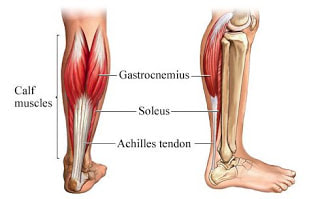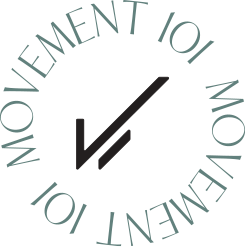|
Calf pain can be due to a specific incident or insidious onset. In this blog we will be dealing with the first type.
The calf is separated into a superficial and deep compartment. In the superficial compartment we find the gastrocnemius, soleus and plantaris muscles. These make up the majority of the calf muscle bulk, with the gastrocnemius and soleus the most commonly affected.
The gastrocnemius muscle is formed of two muscle bellies (see above picture). When activated it assists in bending the knee and the foot i.e. pointing the toes away from the body. It is the most commonly injured muscle of the calf for two main reasons. Firstly, the muscle crosses two joints - the knee and the ankle. The second reason is due to the high density of type-two fast twitch muscle fibers. Due to these reasons it is seen as a more high risk injury. An injury to the gastrocnemius most commonly occurs in the medial head - which is the inside part of your calf.
As can be seen in the picture above, the soleus muscle sits deeper and lower to the gastrocnemius muscle, when activated it flexes the foot. In comparison to the gastrocnemius, the soleus is considered to be a low risk injury as it only crosses one joint, the ankle, and consists mostly of type-one slow twitch muscle fibers. As the muscle sits deeper to the gastrocnemius it can often be mistaken for a gastrocnemius injury. A Calf Strain - what is it? Acute calf injuries often follow a sudden acceleration, such as over stretching or increase in running speed e.g. to run across the road quickly. A calf strain, like any muscular strain in the body is an injury to the muscle resulting in a tear in the fibers of one or multiple calf muscles. The severity of the tear dictates the clinical diagnosis i.e grade I, II or III. A runner usually knows when they have strained their calf, they will often note hearing a tear or popping sound and pinpoint the specific area quite accurately. Depending on the severity of the strain there may be swelling and/or bruising around the calf area down to the ankle. This may start within the first few hours of the injury. Usually it is painful and difficult to walk pain free, with people initially putting their weight through their toes, not wishing to put their heel to the ground. Rehabilitation Clinically, it is important to determine which muscle has been injured as this will play a role in the specific rehabilitation for the strain. It is also very important to understand the multitude of different factors which may have contributed to the injury. This is vitally important as without this understanding the probability of a re-occurrence increases significantly. Rehabilitation following a calf strain begins straight away with acute management over the initial few days. The main focus of this is to decrease swelling/bruising around the area and to return to walking pain free as soon as possible.This is a good indicator of recovery rate going forward. Rehabilitation exercises progressively increase in intensity through the rehabilitation process. They will focus on a variety of areas, with the main aim being on regaining:
Any Questions?
Let us know if you have any questions/queries, or if you need guidance with managing your calf injury and helping you return to your activities and hobbies pain free. Comments are closed.
|
AuthorWrite something about yourself. No need to be fancy, just an overview. Archives
April 2024
Categories |
|
|
|



 RSS Feed
RSS Feed









